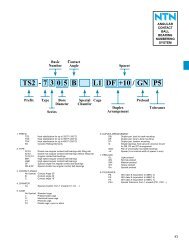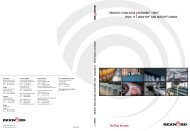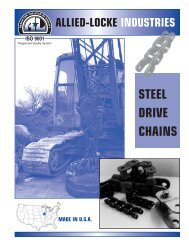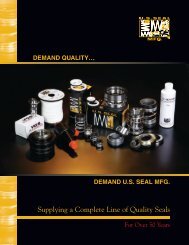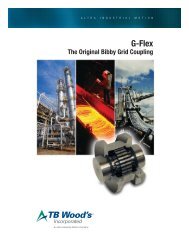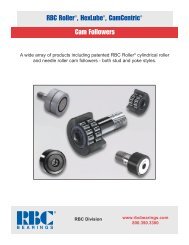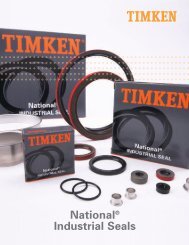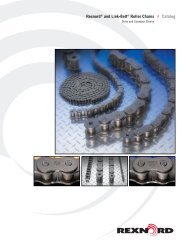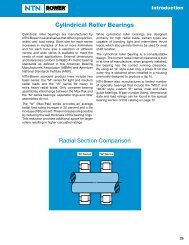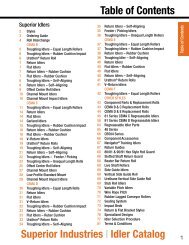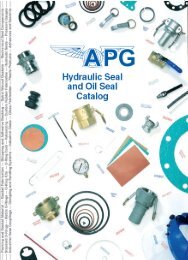- Page 1 and 2:
A L T R A I N D U S T R I A L M O T
- Page 3 and 4:
Table Of Contents Stock Altered and
- Page 5 and 6:
With thousands of stock gears avail
- Page 7 and 8:
Custom Gearing “Request For Quota
- Page 9 and 10:
Custom Gearing Capabilities Gear Ty
- Page 11 and 12:
Gear Selection Stock Gears Spur Gea
- Page 13 and 14:
Product Selection / Reference Guide
- Page 15 and 16:
Product Selection / Reference Guide
- Page 17 and 18:
Product Selection / Reference Guide
- Page 19 and 20:
Boston Gear Helical Gears ■ Paral
- Page 21 and 22:
Boston Gear Worms and Worm Gears
- Page 23 and 24:
A Spur Gears 48 and 32 Diametral Pi
- Page 25 and 26:
A Spur Gears 24 and 20 Diametral Pi
- Page 27 and 28:
A Spur Gears 16 and 12 Diametral Pi
- Page 29 and 30:
A Spur Gears 10 and 8 Diametral Pit
- Page 31 and 32:
A Spur Gears 6 and 5 Diametral Pitc
- Page 33 and 34:
A Change Gears 20 Diametral Pitch (
- Page 35 and 36:
A Change Gears 12 Diametral Pitch (
- Page 37 and 38:
A Change Gears 8 Diametral Pitch (S
- Page 39 and 40:
A Drawn Pinion Wire 48, 32 and 24 D
- Page 41 and 42:
A Internal Gears 48 through 16 Diam
- Page 43 and 44:
A Spur Gears 48 Diametral Pitch (De
- Page 45 and 46:
A Spur Gears 32 Diametral Pitch (De
- Page 47 and 48:
A Spur Gears 24 and 20 Diametral Pi
- Page 49 and 50:
A Spur Gears 12 and 10 Diametral Pi
- Page 51 and 52:
A Spur Gears 6 and 5 Diametral Pitc
- Page 53 and 54:
A Internal Gears 64 through 24 Diam
- Page 55 and 56:
A Spur Gears Approximate Horsepower
- Page 57 and 58:
A Spur Gears Approximate Horsepower
- Page 59 and 60:
A Spur Gears Approximate Horsepower
- Page 61 and 62:
A Spur Gears Approximate Horsepower
- Page 63 and 64:
A Spur Gears Approximate Horsepower
- Page 65 and 66:
A Spur Gears Approximate Horsepower
- Page 67 and 68:
A Spur Gears Approximate Horsepower
- Page 69 and 70:
B Helical Gears 24 through 10 Trans
- Page 71 and 72:
B Helical Gears Selection Procedure
- Page 73 and 74:
B Helical Gears Approximate Horsepo
- Page 75 and 76:
C Miter Gears 48 through 20 Diametr
- Page 77 and 78:
C Miter Gears 8 through 4 Diametral
- Page 79 and 80:
C Bevel Gears 48 through 20 Diametr
- Page 81 and 82:
C Bevel Gears 12 and 10 Diametral P
- Page 83 and 84:
C Spiral Bevel Gears 30 through 8 D
- Page 85 and 86:
C Miter Gears Steel & Iron - Straig
- Page 87 and 88:
C Bevel Gears Steel & Iron - Straig
- Page 89 and 90:
C Notes 84 Boston Gear 800-825-6544
- Page 91 and 92:
D Worms & Worm Gears 48 Diametral P
- Page 93 and 94:
D Worms & Worm Gears 24 Diametral P
- Page 95 and 96:
D Worms & Worm Gears 12 Diametral P
- Page 97 and 98:
D Worms & Worm Gears 8 Diametral Pi
- Page 99 and 100:
D Worms & Worm Gears 4 Diametral Pi
- Page 101 and 102:
D Worms & Worm Gears Selection Proc
- Page 103 and 104:
D Worms & Worm Gears Steel-Hardened
- Page 105 and 106:
E Shaft Couplings FC Series Insert
- Page 107 and 108:
E Shaft Couplings BF Series Bost-Fl
- Page 109 and 110:
E Shaft Couplings SCC Series Clampi
- Page 111 and 112:
E Shaft Couplings FCP Series Sleeve
- Page 113 and 114:
E Universal Joints J/JS Series Bore
- Page 115 and 116:
E Universal Joints UJNS/UJNL Series
- Page 117 and 118:
E Universal Joints JP Series Single
- Page 119 and 120:
E Setscrew Collars SC/SSC Series St
- Page 121 and 122:
E Clamping Collars CSC/CSSC/CASC Se
- Page 123 and 124:
E Thrust Washers Steel and Stainles
- Page 125 and 126:
E Grooved Pulleys G1200 Round Belt
- Page 127 and 128:
E Miniature Timing Belts and Pulley
- Page 129 and 130:
E Miniature HTD ® Timing Belts 3M
- Page 131 and 132:
E Timing Belt Pulleys PA Series For
- Page 133 and 134:
E Timing Belt Pulleys PLB Series Fo
- Page 135 and 136:
E Miniature HTD ® Timing Belts 5M
- Page 137 and 138:
E Timing Belt Pulleys PA Series For
- Page 139 and 140:
E Timing Belt Pulleys PLB Series Fo
- Page 141 and 142:
F BOST-BRONZ Oil-Impregnated Sinter
- Page 143 and 144:
F BOST-BRONZ Oil-Impregnated Sinter
- Page 145 and 146:
F BOST-BRONZ Oil-Impregnated Sinter
- Page 147 and 148:
F BOST-BRONZ Oil-Impregnated Sinter
- Page 149 and 150:
F BOST-BRONZ Oil-Impregnated Sinter
- Page 151 and 152:
F BEAR-N-BRONZE 660 Cast Bronze Bea
- Page 153 and 154:
F BEAR-N-BRONZE 660 Cast Bronze Bea
- Page 155 and 156:
F BEAR-N-BRONZE 660 Cast Bronze Bea
- Page 157 and 158:
F BEAR-N-BRONZE 660 Cast Bronze Bea
- Page 159 and 160:
F Bronze Bearing Emergency Banks Ac
- Page 161 and 162:
F BOStonE F-1 Glass Filled Teflon B
- Page 163 and 164:
F RULON ® 641 Bearings Boston Gear
- Page 165 and 166:
F BOStonE Molded Plastic Bearings B
- Page 167 and 168:
F BOStonE Molded Plastic Bearings R
- Page 169 and 170:
F BOStonE Molded Plastic Bearings R
- Page 171 and 172:
F BOStonE Molded Plastic Bearings R
- Page 173 and 174:
F BOStonE Molded Plastic Bearings R
- Page 175 and 176:
F BOStonE Molded Plastic Bearings G
- Page 177 and 178:
F BOStonE Molded Nylon Bearings Pla
- Page 179 and 180:
F Engineering Information Sleeve Be
- Page 181 and 182:
F Engineering Information Sleeve Be
- Page 183 and 184:
F Engineering Information Lubricati
- Page 185 and 186:
F Engineering Information Shaft Cle
- Page 187 and 188:
F Engineering Information Machining
- Page 189 and 190:
F Anti-Friction Bearings Ball Beari
- Page 191 and 192:
F Anti-Friction Bearings 1600 Serie
- Page 193 and 194:
F Anti-Friction Bearings 7600 Serie
- Page 195 and 196:
F Anti-Friction Bearings 3000 Serie
- Page 197 and 198:
F Anti-Friction Bearings Flanged 40
- Page 199 and 200:
F Anti-Friction Bearings 600 Series
- Page 201 and 202:
F Anti-Friction Bearings 2100 Serie
- Page 203 and 204:
F Self-Aligning Bearings KF Female
- Page 205 and 206:
F Self-Aligning Bearings CMHD Male/
- Page 207 and 208:
F Self-Aligning Bearings HME Male/H
- Page 209 and 210:
F Self-Aligning Bearings LHA-LHB-LH
- Page 211 and 212:
F Self-Aligning Bearings LS/LSS Ser
- Page 213 and 214:
F Engineering Information Engineeri
- Page 215 and 216:
F Engineering Information Engineeri
- Page 217 and 218:
F Mounted Bearings Replacement Bear
- Page 219 and 220:
F Mounted Bearings Replacement Bear
- Page 221 and 222:
F Mounted Ball Bearings PS Series P
- Page 223 and 224:
F Mounted Ball Bearings L/H Series
- Page 225 and 226:
F Mounted Ball Bearings SL/SH Serie
- Page 227 and 228:
F Mounted Ball Bearings MB Series P
- Page 229 and 230:
F Mounted Ball Bearings XL2/XL3 Ser
- Page 231 and 232:
F Mounted Ball Bearings F/T Series
- Page 233 and 234:
F Mounted Ball Bearings SF/ST Serie
- Page 235 and 236:
F Mounted Ball Bearings MBP Series
- Page 237 and 238:
F Mounted Bearings TU Series Take-U
- Page 239 and 240:
F Engineering Information Analysis
- Page 241 and 242:
F Engineering Information Mounted B
- Page 243 and 244:
F Engineering Information Applicati
- Page 245 and 246:
F Notes 240 Boston Gear 800-825-654
- Page 247 and 248:
G Roller Chains Description of Roll
- Page 249 and 250:
G Roller Chains ANSI Standard Doubl
- Page 251 and 252:
G Engineering Information Conveyor
- Page 253 and 254:
G Engineering Information Conveyor
- Page 255 and 256:
G Notes 250 Boston Gear 800-825-654
- Page 257 and 258:
G Roller Chains Hollow Pin Single a
- Page 259 and 260:
G Ladder Chain Steel-Stainless Stee
- Page 261 and 262:
G Chain Pullers Chain Breaking Tool
- Page 263 and 264: H Chain Drives Roller Chain Sprocke
- Page 265 and 266: H Roller Chain Drives Horsepower Ra
- Page 267 and 268: H Roller Chain Drives Horsepower Ra
- Page 269 and 270: H Roller Chain Drives Selection SPE
- Page 271 and 272: H Miniature Chain Sprockets Single
- Page 273 and 274: H Roller Chain Sprockets Single Str
- Page 275 and 276: H Roller Chain Sprockets Single Str
- Page 277 and 278: H Roller Chain Sprockets Single Str
- Page 279 and 280: H Roller Chain Sprockets Single Str
- Page 281 and 282: H Roller Chain Sprockets Single Str
- Page 283 and 284: H Roller Chain Sprockets Single Str
- Page 285 and 286: H Roller Chain Sprockets Single Str
- Page 287 and 288: H Roller Chain Sprockets Single Str
- Page 289 and 290: H Roller Chain Sprockets Single Str
- Page 291 and 292: H Roller Chain Sprockets Single Str
- Page 293 and 294: H Roller Chain Sprockets Single Str
- Page 295 and 296: H Block Chain Sprockets Type B Sing
- Page 297 and 298: H Ladder Chain Sprockets Type B Sin
- Page 299 and 300: H Roller Chain Drive Tensioners Typ
- Page 301 and 302: H Roller Chain Drive Tensioners Typ
- Page 303 and 304: I Engineering Information Spur Gear
- Page 305 and 306: I Engineering Information Spur Gear
- Page 307 and 308: I Engineering Information Spur Gear
- Page 309 and 310: I Engineering Information Helical G
- Page 311 and 312: I Engineering Information Helical G
- Page 313: I Engineering Information Miter and
- Page 317 and 318: I Engineering Information Couplings
- Page 319 and 320: I Engineering Information General M
- Page 321 and 322: I Engineering Information Sprockets
- Page 323 and 324: I Engineering Information Sprocket
- Page 325 and 326: I Engineering Information Temperatu
- Page 327 and 328: I Engineering Information Metric Co
- Page 329 and 330: I Engineering Information Applicati
- Page 331 and 332: I Index to Catalog Numbers Catalog
- Page 333 and 334: I Index to Catalog Numbers Catalog
- Page 335: Altra Industrial Motion All Custome




